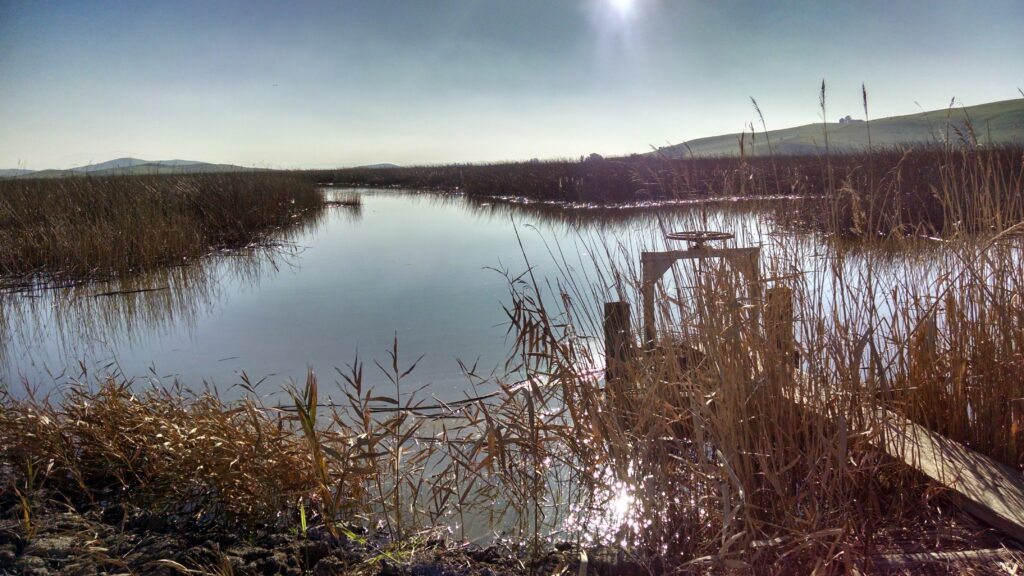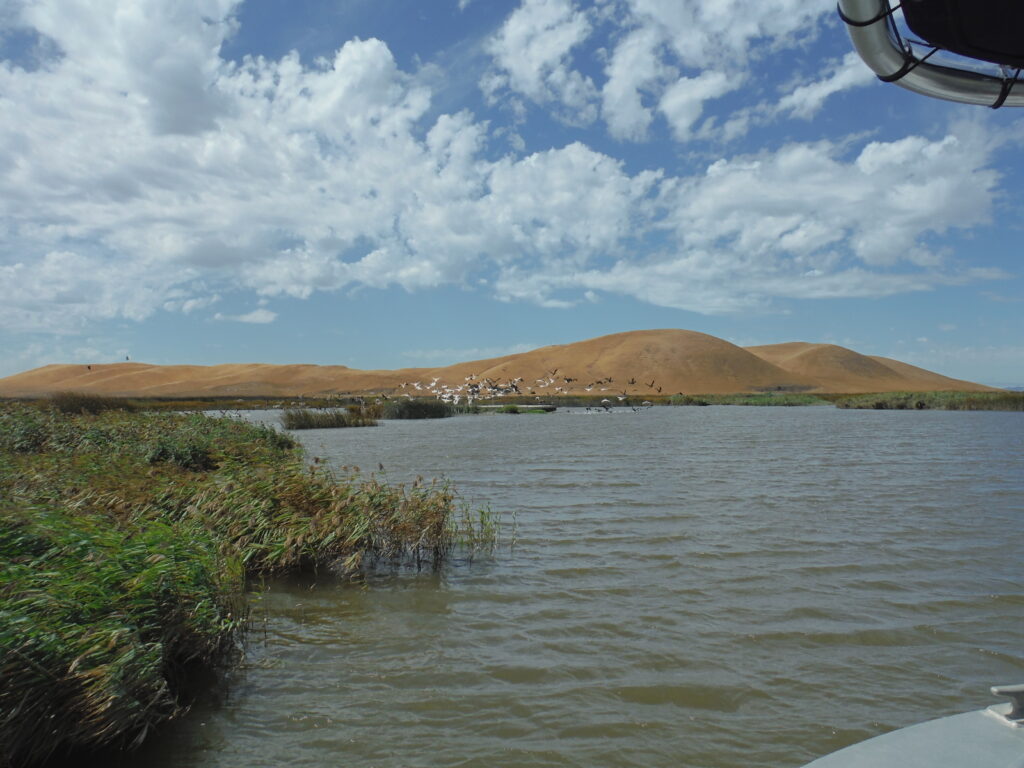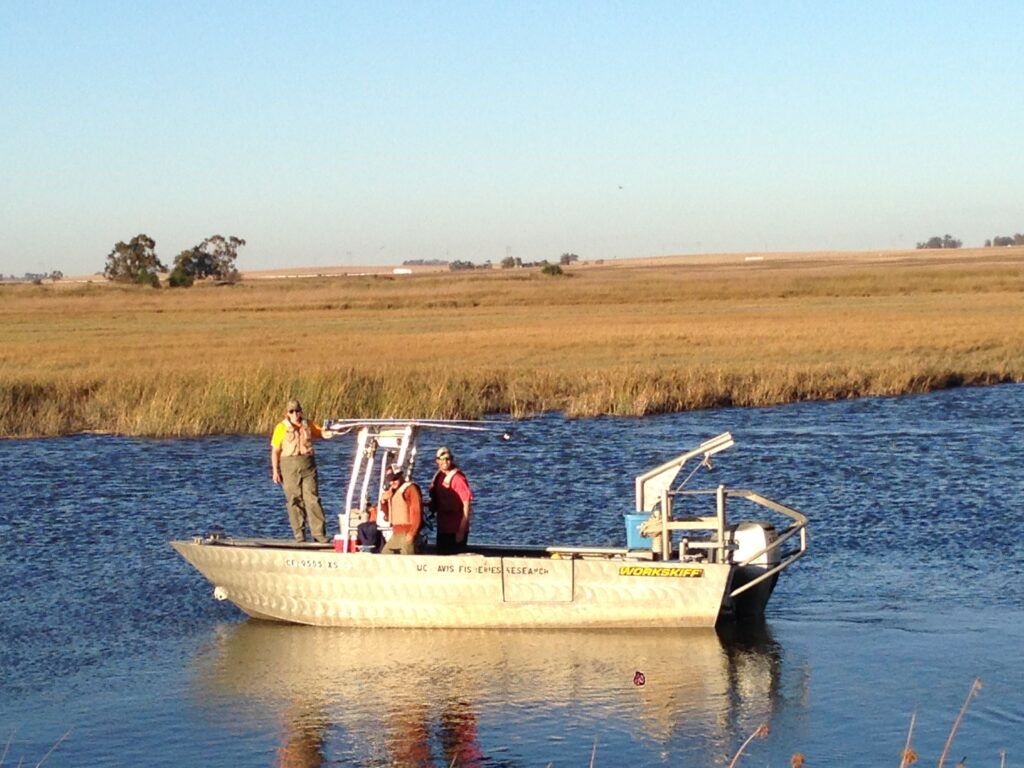
On a sunny spring day in 2014, two UC Davis PhD candidates in waders pulled a 30-foot seine through Luco Pond (also known as the Potrero Duck Club) in Suisun Marsh. Luco Pond is within the Nurse-Denverton Slough Complex where duck clubs use tidal gates to control water exchange. After 45 minutes of counting diminutive fish, Brian Williamshen and Melissa Riley were excited to tally more than 6,900 sticklebacks, a thorny-backed native fish in the Sacramento-San Joaquin River Delta.
“There was definitely a moment of excitement,” Williamshen says. “But when we were at our 50th fish, and the little spines kept poking us in the fingers, our emotions shifted to like, oh man, we still have hundreds more to go!”
Several months later, Williamshen pulled a seine at Blacklock Marsh, another site in the Nurse-Denverton Slough Complex. Blacklock is a former duck club that was restored to an open tidal marsh with two breaches in 2006. One of the goals of the project was to improve habitat for endangered species like Delta smelt, but instead of finding native fish, Williamshen counted 874 Mississippi silversides, an invasive fish that had flowed in unrestricted with the tides.
“Silversides compete with species like Delta smelt,” says Peter Moyle, UC Davis professor emeritus who started the Suisun Marsh Fish Study in 1980. “When silverside numbers are high, other fish numbers tend to go down.”
Moyle’s monthly fish study was taken up by the Aquatic Research Collective at UC Davis’ Center for Watershed Studies after he switched to emeritus status, though Moyle continues to serve as an advisor.
The passage of California Proposition 1 resulted in a push to restore wetland habitat, including the conversion of “working” wetlands to open tidal wetlands in the Suisun Marsh. Williamshen’s two-year study kicked off a series of studies that have been conducted by the Aquatic Research Collective to determine if the restoration of managed wetlands in the Suisun Marsh were achieving their goals to help native fishes.
“Our findings, over and over again, come back to the same conclusion” says John Durand, senior researcher at the Collective. “We’re seeing a degradation in the quality of habitat as a result of wetland-to-wetland restorations.”

Though much of San Francisco Bay’s wetlands have been filled and built upon, most of the Suisun Marsh has been conserved by more than 150 private duck clubs for hunting. Managed wetlands are ecologically functional habitats, and not just for waterfowl, Durand says. It turns out they are good for aquatic food production and fish, too.
Durand didn’t start out thinking this way. Neither did Moyle, who says that fish people tended to ignore duck club people until about ten years ago when UC Davis students sampled water at duck clubs in Luco Pond. Their findings demonstrated that duck club ponds could be a significant source of food for fish.
Duck clubs close their tidal gates in summer when they grow annual plants such as fat hen and sea purslane to attract waterfowl. In autumn the clubs open their gates to exchange water with adjacent sloughs. Plant materials decay and seeds float to the surface, resulting in “giant blooms of productivity that are phenomenal,” says Durand.
Blooms like these may help mitigate a decline in plankton that has occurred in the San Francisco Estuary since the late 1980s, primarily due to the ravenous appetite of invasive clams. The lack of food at the base of the web has contributed to a decline in fish, including Delta smelt and Chinook salmon.
Williamshen was one of the undergrad students who had sampled water in Luco Pond. After he graduated, the Aquatic Research Collective helped him design a study. From October 2013 to July 2015, Williamshen and his team (including Melissa Riley, Teejay O’Rear, Durand, and Moyle) motored through sloughs and bays to sample water quality, zooplankton, and macroinvertebrates. They captured, identified, and measured fish at Blacklock Marsh, Luco Pond, Little Honker Bay, and Arnold, Luco, and Denverton sloughs.
“We were dismayed to see that there was a negative effect at Blacklock compared to adjacent habitats,” says Durand. Williamshen’s study was the first to show that the restoration of a managed wetland can have counterintuitive results, while also showing that an adjacent managed wetland was extraordinarily productive.
Williamshen concluded in his paper published in the March 2021 issue of Restoration Ecology, “Our research suggests that restoring tidal action to managed wetlands alone may worsen rather than improve conditions for at-risk and native fishes.”

The Aquatic Research Collective next evaluated managed ponds as potential Chinook salmon nurseries. In spring 2017, Master of Science candidate Nicole Aha (now Kwan) grew juvenile salmon in cages at four sites: a natural tidal slough, a leveed tidal slough, and at the inlet and outlet of a managed wetland. “We expected salmon to grow fastest in the natural tidal slough because it best represents historic salmon habitat in the marsh,” she says.
To prepare for her experiment, Kwan and her team (Nann Fangue, Andrew Rypel, Moyle, and Durand) evenly divided 252 fall-run juvenile Chinook salmon grown in a UC Davis lab into 18 cylindrical cages. Then they reared the .01-ounce salmon in cages placed in First Mallard Slough, a natural tidal slough at Rush Ranch; Sheldrake Slough, a leveed tidal slough between two managed wetlands; and an inlet and outlet of Wings Landing Duck Club. From March 1 to April 21, 2017, Kwan weighed and measured the fish every two weeks. On each visit, she euthanized three fish per cage and took them back to the lab to examine what was in their stomachs.
“What she found blew her away,” says Durand. “The fish did not do well in the natural slough and the fastest growth occurred near the outlet of the managed pond.”
Kwan concluded in a paper published in the April 2020 issue of Estuaries and Coasts, “This is the first study in the San Francisco Estuary to demonstrate that a productive tidally muted managed pond can benefit rearing salmon. Contrary to our expectation, salmon grew considerably faster in the managed pond outlet relative to the other locations, with observed growth rates that were comparable to other productive habitats.”
Salmon grown and studied in productive habitats include the “floodplain fatties” reared in flooded rice fields in the Yolo Bypass. Around the same time that the Aquatic Research Collective was conducting its studies in the Suisun Marsh, another group of scientists at UC Davis’s Center for Watershed Sciences was monitoring the growth rate of juvenile salmon in flooded rice fields. They watched the salmon grow fast and fat because the flooded rice fields created phytoplankton or mobilized detritus. Either of these phenomena can fuel a zooplankton bloom that feeds baby fish. “We find the same effect here,” Durand says. “It’s the managed working landscapes that are extremely beneficial.”
In another study, the Aquatic Research Collective compared plankton production in managed wetlands to adjacent tidal waterways. In that 2018-2021 study, UC Davis PhD candidates Alice Tung and Kyle Phillips confirmed that ponds produce more food for fish than do tidal waters. They completed a Suisun Pond Productivity report in 2021, but their papers on the study have yet to be published.
The Collective has funding to further their studies. One will expand on Nicole Kwan’s work. In another they will look at how managed wetlands work, why they’re productive, and what can be done to manage them more effectively for fish and fowl. Decades of data from the Suisun Marsh Fish Study reveal that Suisun Marsh has the most diverse community of fishes in the upper San Francisco Estuary, and Durand believes its managed wetlands, including those in the Nurse-Denverton Slough Complex, are a factor in that.

The slough complex stretches from Montezuma Slough to California State Route 12 west of the Western Railway Museum. Nurse Slough flows along the west side of Broadmoor Island and splits into the sinewy sloughs of Luco and Denverton, flanked by tules, cattails, and common reeds. Denverton Slough slips under CA-12 into ephemeral drainage, while Luco Slough joins Luco Pond where duck clubs exchange water at the same time native fishes are in their larval stages and growing on zooplankton.
The Nurse-Denverton Slough Complex is unique among San Francisco Estuary wetlands for another reason. Its upper reaches are connected to uplands that aren’t urbanized or built upon, giving the marsh room to migrate when sea levels rise. “Climate change is going to alter this landscape without active management. At sites where we simply breach the habitat, like at Blacklock, sea-level rise will flood them in the next 50 years or so and they’re going to become subtidal habitat and lose a lot of benefit,” says Durand.
The marsh could provide some protection if it were altered to maintain the landscape. “One way to do that is by working with private duck club owners,” says Durand. “I suspect that the private and state owners of managed wetlands will resist [rising waters] because they have more incentive to do so. We should be forming partnerships with landowners in the region to try to help them maintain and buffer their levees.”

A portion of Luco Pond is being considered for open tidal restoration. The Aquatic Research Collective believes that would be a mistake. “We should understand it before we decide to breach it and put in the kind of restoration that my group keeps finding is not very productive,” says Durand. “We think we’ll see a degradation of the whole system.”
Instead of restoring managed wetlands into open tidal wetlands, Durand and his Collective envision a restoration model that manages connectivity. “Having a coupled system, like a working landscape with a naturalistic landscape, could be highly productive [for fish]. Geomorphology, active management and water hydrology would all come together in this,” Durand says. “It’s complicated, but it could be more productive than the sort of restorations we’re doing now. The breach and hope strategy is just not very useful.”
Williamshen says that doing his study shifted the perspective he had learned in school. “It’s important for people to know that our science is showing that it’s not what we thought. Instead of these duck clubs being harmful, they’re productive and benefit native fish. You think you’re doing good for the ecosystem by restoring it, but we’re finding that’s not actually the case.”
A decade of studies has left Durand asking, “Why create ‘new’ wetland habitats out of wetland habitats that are already functional?” This question, and the pursuit of data that can help answer it, continues.
Top Photo: Seining Luco pond. Photo: Brian Williamshen
Managed Wetlands Can Benefit Juvenille Chinook Salmon in a Tidal Marsh
Tidal Wetland Restoration Favors Non-Natives